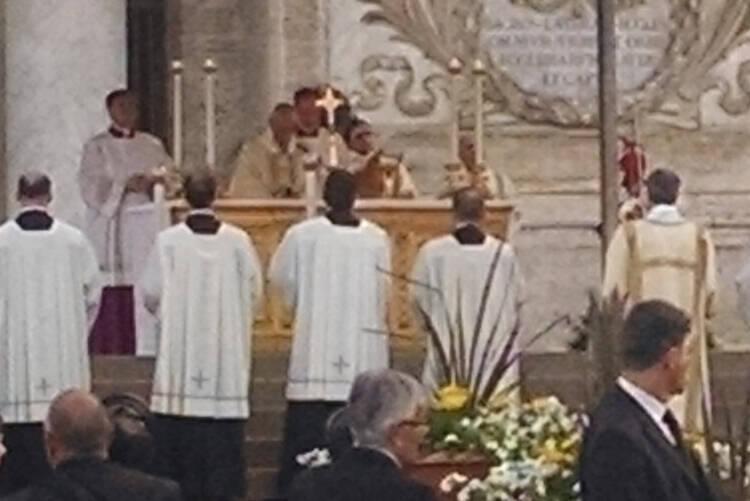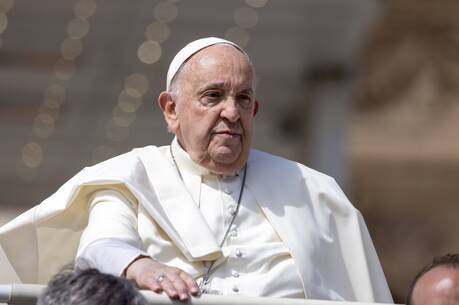I noticed on Twitter last Thursday, in a stray-minded moment at a Notre Dame conference near the Colosseum, that Pope Francis would be saying Corpus Christi Mass that evening in front of St. John Lateran, just a few blocks away from the meeting rooms. I went with a group of scholars—experts in global Islam and Catholicism, mainly—as well as a fellow magazine reporter from New York—an eminent one, and a Jew. She and I stuck together as we made our way into the gathering crowd an hour and a half early, after the appropriate on-site bureaucrat declared our effort to secure press privileges “impossible.” So we ventured among the tourists and families, the restless boys and determined old women. There were stray nuns among us too, but must of the nuns were cordoned off to the side in row after row of seats, organized in patches of color associated with the habits of this or that order. A few had no habits at all, but very few. The bloc of them formed the long base of an imaginary cross, whose center was the altar; the arms were large, elevated blocs of men (except for a few nuns at the very back), from cardinals to seminarians to members of this or that costumed fraternity; the head, of course, was Pope Francis.
His voice was about as close as we could get to him. Wilting and sweet, but with a throaty fullness of timbre, it made the whole square into a private chapel. In the penitential rite, in the homily (whose meaning, except for the predictable ecclesial words, I only caught in news reports the next morning), in the Eucharistic prayers, his voice was at once a whisper in each of our ears and an echo off the facades of the buildings along the perimeter. Except when a blaring ambulance needed to break through the crowd, the silence between his words was absolute, and his syllables eased in and out of that silence like a violin, like a whale surfacing for air.
 The Mass was long and high. We followed along with the Gregorian notation in glossy booklets that boy scouts handed out along with bottles of water. A nun not far from us interpreted the liturgy in sign language. It was hard to see the distant activity at the altar through all the arms raising up phones and tablets and cameras to capture some outline of the proceedings. At communion I received the Body on my tongue for the first time in my life that I can recall, from the fingers of a priest reaching into the crowd across a barricade. At the end, slowly, a procession formed toward Maria Maggiore, starting with groups of priests and cardinals, who made their way from their seats of honor leisurely, spaced out, and flanked by guards in various shades of uniform. Ushers in coats and tails guided them. May readers forgive me for not knowing better the proper designations and titles associated with each set of dignitaries; but surely in that deficit, among the longing, listening, doubting, and supplicating throng of souls that surrounded me there, I was not alone.
The Mass was long and high. We followed along with the Gregorian notation in glossy booklets that boy scouts handed out along with bottles of water. A nun not far from us interpreted the liturgy in sign language. It was hard to see the distant activity at the altar through all the arms raising up phones and tablets and cameras to capture some outline of the proceedings. At communion I received the Body on my tongue for the first time in my life that I can recall, from the fingers of a priest reaching into the crowd across a barricade. At the end, slowly, a procession formed toward Maria Maggiore, starting with groups of priests and cardinals, who made their way from their seats of honor leisurely, spaced out, and flanked by guards in various shades of uniform. Ushers in coats and tails guided them. May readers forgive me for not knowing better the proper designations and titles associated with each set of dignitaries; but surely in that deficit, among the longing, listening, doubting, and supplicating throng of souls that surrounded me there, I was not alone.
At last came a white pickup truck, which had on its bed a white canopy with retractable, red-carpeted stairs in back. The Blessed Sacrament was placed on a stand there, and a pair of strong-kneed priests knelt before it, clinging to the railing as discreetly as they could while the stairs were retracted and the truck began lunging forward into the procession. (According to Catholic News Service—I couldn’t have seen it myself—the truck bore the plate “SCV 1,” which is normally that of the Holy Father.) Soon, the sea of nuns began surging into a river behind it, with none of the careful pacing and leisure that had been allotted the clerical dignitaries, for in the nuns’ case it was clear that the Sacrament would not be waiting around for them. Behind and among them was everyone else, many carrying candles into the dusk of a perfect, clear, warm night.
I don’t think I’ve ever seen the situation in such fullness of force. I see traces of this at Mass each Sunday, but the altar girls and the fierce women in the front pews help to offset the effects. I saw Benedict XVI pass by twice as pope, once in St. Peter’s Square and another time on Fifth Avenue in New York, but the order of things is less evident in passing. At St. John Lateran there were probably hundreds of men closer to Francis than the closest woman, and given the courtly origins of the choreography, this is a meaningful distance. That distance is distance from power, from voice. This is not complementarity, it is hierarchy. I’m sorry: It is patriarchy. And the church that I love tolerates it, persists in it, insists on it—as if it is of a piece with the beauty of the costumes and the music and the gospel. Peter hid from the cross while Mary stayed, yet his heirs are blocking the view of hers. My companion, the Jewish reporter, was less surprised than I; she found the spectacle easier, simply, to enjoy.
In a million ways I thank God that the church is slow and insistent that old things still matter. Maybe this dramaturgy (inadvertently) serves to remind us that the domination of men remains rampant in our societies, despite the hasty optics of political correctness that might claim it is over and done. Maybe we need to hold on to this liturgical territory so it can be the site of a final Armageddon against sexism everywhere, once and for all. In a way the church is perpetually like this—at once, a display of the love that we long for, and also of what we’re up against in ourselves.









I agree with much of what you say, including the grace of slowness in the church, which I am in many respects grateful for. Also, I should clarify that I don't think the Mass was in any respect "spoiled" for me; the risen Christ was still present in it, regardless of the choreography.
It strikes me as strange to say that what you call the "grievance industry" is what is fixated on power. Nowhere more than in our church today does one find such clearly orchestrated dramas in which the lines of power are made visible. And I don't have any quarrel with that; indeed, all the better that hierarchies should be explicit rather than implicit, on display rather than behind closed doors. I don't object to hierarchies here per se; I mourn for how they are organized—with such a clear divide between male and female, with male in the position of dominance and preference—because I think in the process many "special gifts and roles," as you put it, are not being given their full opportunity to shine. Power is part of how we incarnate our calling to be a church, and how we distribute power is, in some senses, part of our worship.
I'm glad we share the goal of a church that is truly universal, in which people can come together as one. I hope that the tone of my article is not divisive, except insofar as it highlights divisions that already plague us, and that beg us to reconciliation.
Just to clarify: I think we can at least partly bracket the question of women's ordination here. Many of those men up near the pope were not priests (though many were). Just as Pope Francis has called for women to play a greater leadership role in the church while not entertaining ordination, I think it would be reasonable to expect that women (religious and lay) can play a more prominent role in the papal liturgy without necessarily being ordained. Indeed, I think that would make a stronger statement about complimentarity; it would demonstrate that, even if women are not priests, their presence and ministry are no less equally valued.